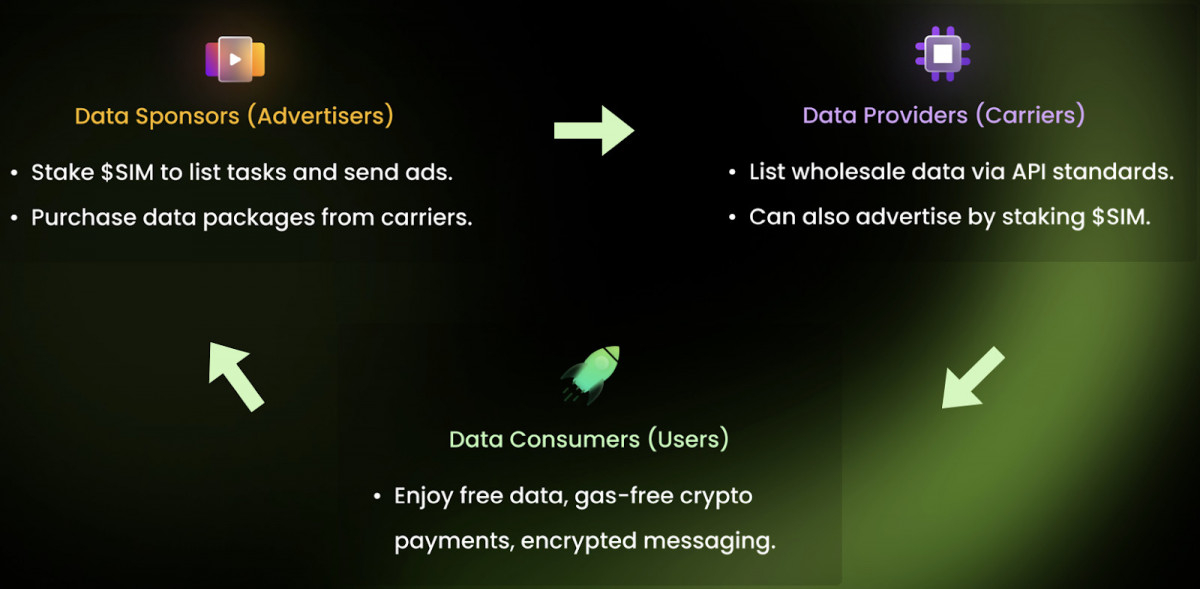Exploring the Future of Mobile Communications: The Role of DeSIM in the Context of Cryptocurrencies, IoV, and Metaverses
In Brief
DeSIM is an exciting new area that aspires to revolutionize mobile networks by seamlessly merging established technologies with the principles of Web3.

Web3 technologies have enabled a groundbreaking shift in digital infrastructure, prioritizing decentralization, user agency, and innovative economic models. Within this evolution, decentralized SIM technology (DeSIM) emerges as a transformative force for mobile network operations. as reported in the new research by CGV DeSIM aims to innovate communication networks by fusing conventional mobile technology with Web3 solutions, fostering lower costs, richer innovation, and enhanced security.
The Evolution of Mobile Network Providers
Mobile Network Operators (MNOs) have been the backbone of the telecom industry for years. They manage extensive infrastructure projects that create significant barriers to entry for competitors, benefiting from economies of scale.
The introduction of Mobile Virtual Network Operators (MVNOs) brought a welcome layer of flexibility, enabling service providers to rent network capacity and offer tailored or cost-effective services. Nonetheless, the centralized nature of these models often limits their ability to solve critical issues, such as user empowerment, privacy, and adaptability.
The emergence of DeSIM aims to change this landscape. Integrating blockchain technology, DeSIM introduces decentralized philosophies into mobile communications, allowing for user-centric, adaptable network participation and a decentralized method for identity verification. This vision places Web3 network operators at the forefront, prioritizing community-led infrastructure building, decentralized identity oversight, and participatory incentives.
Qualities of Web3 Network Operators
What distinguishes Web3 network operators from traditional MNOs and MVNOs is their incorporation of blockchain and tokenomics into their operational models. By decentralizing key communication functions, this innovative approach enhances user empowerment and propels technological advancement.
One standout characteristic of Web3 network operators is the integration of cryptocurrencies. These operators facilitate seamless global transactions while reducing reliance on traditional banking systems, using digital currencies for payments and other service applications. Furthermore, decentralized identity management through blockchain-enabled decentralized identifiers (DIDs) enhances personal data privacy, providing secure and user-controlled authentication.
The value proposition of Web3 operators leans heavily on tokenized ecosystems that establish compelling financial incentives for community engagement and development. By rewarding users for contributing to network infrastructure or sharing data, these networks elevate privacy standards through decentralized storage and robust end-to-end encryption, mitigating threats such as SIM swap fraud.
Target User Demographics
DeSIM operators cater to a diverse group of users who gain significant benefits from decentralized communication networks. This includes early adopters like cryptocurrency enthusiasts, frequent travelers, and privacy-focused individuals who appreciate features such as secure communications, international roaming without restrictive contracts, and opportunities for savings through token rewards.
Moreover, enterprises in the Web3 space can reap substantial benefits. Blockchain firms, DeFi providers, and IoT companies can leverage DeSIM solutions to enhance their connectivity and scalability, embedding decentralized principles into their operational frameworks.
Technological Foundations Underpinning DeSIM
Advancements in SIM technology have enabled the transition toward decentralized mobile communications. Innovations such as software-based SIMs, eSIMs, vSIMs, and iSIMs have broken the constraints of traditional physical SIM cards.
- eSIM: These embedded SIMs allow for remote provisioning and the use of multiple network profiles, enhancing flexibility for global roaming.
- vSIM: Virtual SIMs remove the dependence on physical hardware, utilizing cloud-based identity management for versatile user authentication.
- iSIM: Integrated SIMs embed SIM functionality directly into devices, reducing their size and energy usage.
- Soft SIM: Completely software-driven SIM solutions maximize flexibility while creating challenges for security and standardization.

Case Studies of DeSIM Operators
A multitude of instances illustrates the adaptability and scalability of DeSIM applications, showcasing the expansive potential of Web3 network operators.
Helium Mobile
For instance, Helium merges community-based hotspot deployments with a centralized network framework, utilizing a dynamic coverage model in collaboration with T-Mobile. Users earn $Mobile tokens for contributing to network coverage, creating a decentralized, token-incentivized ecosystem that boosts service scalability and affordability.

Depinsim
Built on the TON blockchain, this SIM solution merges mobile communication with decentralized identity and payment frameworks. Its eSIM technology supports global roaming and employs tokenized tasks and advertisements to engage users, all while focusing on privacy through blockchain security and end-to-end encryption.

XPIN
XPIN places a focus on the Internet of Things by offering vSIM solutions governed by decentralized protocols. By enabling IoT devices to operate as blockchain nodes, XPIN enhances data security and identity management, promoting seamless connectivity between devices. Its layered approach, which includes hardware integration and global eSIM services, positions XPIN as a versatile operator for personal and commercial requirements.

Prospects for the Future
When integrated with emerging industries, DeSIM technology holds the potential to spur innovation across various sectors. For example, vehicles enabled with DeSIM could function as mobile base stations within the Internet of Vehicles (IoV), creating dynamic mesh networks for improved coverage while encouraging vehicle owners to share bandwidth resources, thereby fostering a collaborative and decentralized network structure.
Collaborations with low-Earth orbit satellite networks such as Starlink could extend DeSIM's influence in satellite communications. By merging satellite and land-based networks, a consistent communication system could be established, particularly beneficial in underserved or rural regions. This integration has the capacity to revolutionize global communication infrastructure by overcoming geographical and technical challenges.
The metaverse also presents vast opportunities for DeSIM. To create immersive and interactive virtual realities, low-latency networks and decentralized identification systems are crucial. Through secure identity verification and efficient data transfer, DeSIM can facilitate seamless interactions among users and digital assets across various virtual platforms, laying the groundwork for a connected and user-centric metaverse environment.
Disclaimer
In line with the Trust Project guidelines Please keep in mind that the information on this page is not intended as legal, tax, investment, or financial guidance. It is crucial to invest only what you can afford to lose and to seek independent financial advice where needed. For more details, please review the terms, conditions, and support resources provided by the issuer or advertiser. MetaversePost strives for precise and impartial reporting, although market conditions can fluctuate unexpectedly.







